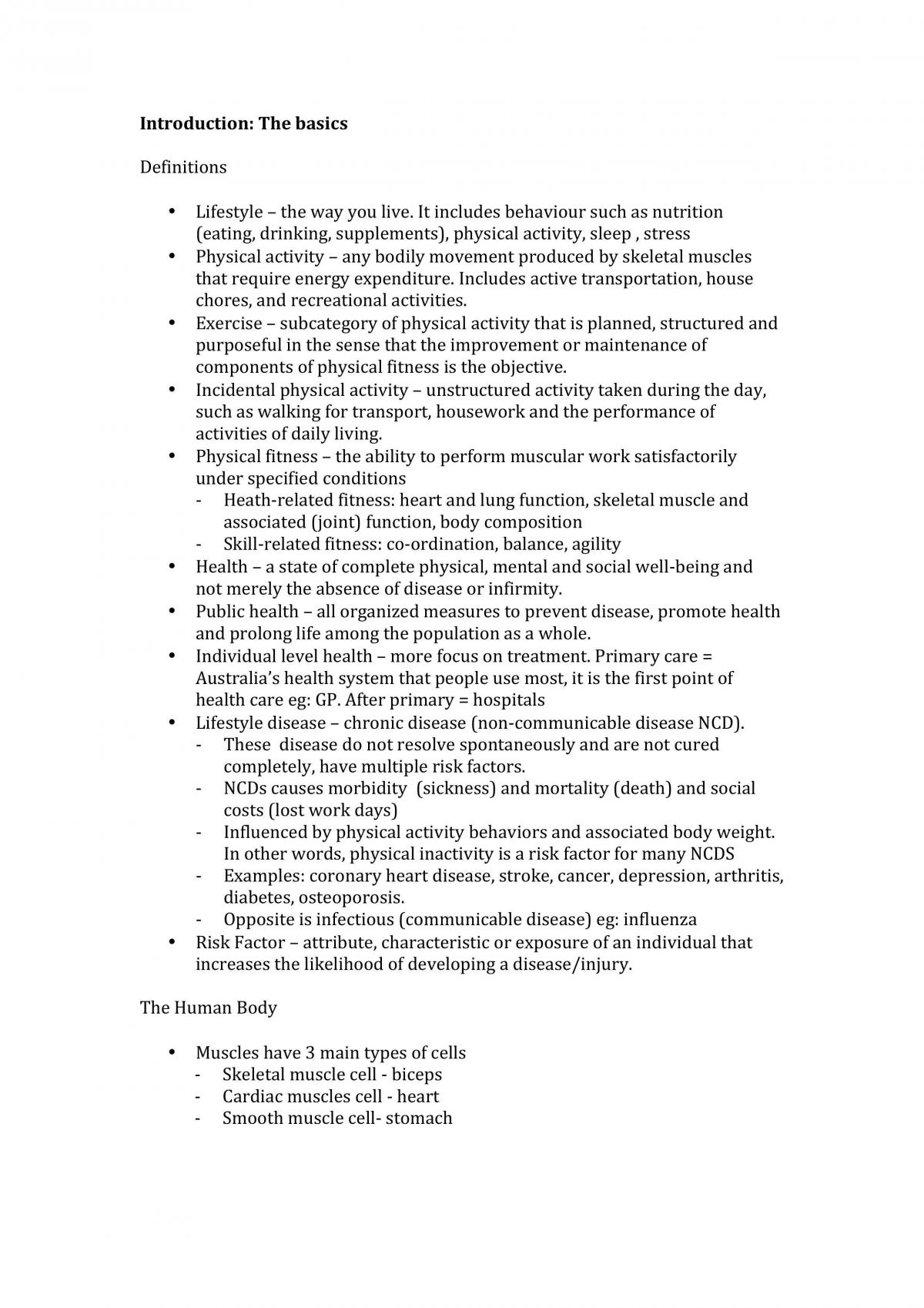Find
Search for over 200,000 study notes and past assignments!
Swap
Download study resources by swapping your own or buying Exchange Credits.
Study
Study from your library anywhere, anytime.
GENM0703 Exam Study Notes
GENM0703 - Concepts of Physical Activity, Exercise and Health
26 Pages • Complete Study Notes • Year: Pre-2021
• Lifestyle – the way you live. It includes behaviour such as nutrition (eating, drinking, supplements), physical activity, sleep , stress • Physical activity – any bodily movement produced by skeletal muscles that require energy expenditure. Includes active transportation, house chores, and recreational activities. • Exercise – subcategory of physical activity that is planned, structured and purposeful in the sense that the improvement or maintenance of components of physical fitness is the objective. • Incidental physical activity – unstructured activity taken during the day, such as walking for transport, housework and the performance of activities of daily living. • Physical fitness – the ability to perform muscular work satisfactorily under specified conditions - Heath-related fitness: heart and lung function, skeletal muscle and associated (joint) function, body composition - Skill-related fitness: co-ordination, balance, agility • Health – a state of complete physical, mental and social well-being and not merely the absence of disease or infirmity. • Public health – all organized measures to prevent disease, promote health and prolong life among the population as a whole. • Individual level health – more focus on treatment. Primary care = Australia’s health system that people use most, it is the first point of health care eg: GP. After primary = hospitals • Lifestyle disease – chronic disease (non-communicable disease NCD). - These disease do not resolve spontaneously and are not cured completely, have multiple risk factors. - NCDs causes morbidity (sickness) and mortality (death) and social costs (lost work days) - Influenced by physical activity behaviors and associated body weight. In other words, physical inactivity is a risk factor for many NCDS - Examples: coronary heart disease, stroke, cancer, depression, arthritis, diabetes, osteoporosis. - Opposite is infectious (communicable disease) eg: influenza • Risk Factor – attribute, characteristic or exposure of an individual that increases the likelihood of developing a disease/injury.
This document is 25 Exchange Credits
More about this document:
|
|
This document has been hand checkedEvery document on Thinkswap has been carefully hand checked to make sure it's correctly described and categorised. No more browsing through piles of irrelevant study resources. |
|
|
This is a Complete Set of Study NotesComplete Study Notes typically cover at least half a semester’s content or several topics in greater depth. They are typically greater than 20 pages in length and go into more detail when covering topics. |
|
|
What are Exchange Credits?Exchange Credits represent the worth of each document on Thinkswap. In exchange for uploading documents you will receive Exchange Credits. These credits can then be used to download other documents for free. |
|
|
Satisfaction GuaranteeWe want you to be satisfied with your learning, that’s why all documents on Thinkswap are covered by our Satisfaction Guarantee. If a document is not of an acceptable quality or the document was incorrectly described or categorised, we will provide a full refund of Exchange Credits so that you can get another document. For more information please read Thinkswap's Satisfaction Guarantee. |

Studying with Academic Integrity
Studying from past student work is an amazing way to learn and research, however you must always act with academic integrity.
This document is the prior work of another student. Thinkswap has partnered with Turnitin to ensure students cannot copy directly from our resources. Understand how to responsibly use this work by visiting ‘Using Thinkswap resources correctly’.
Browse UNSW Subjects




